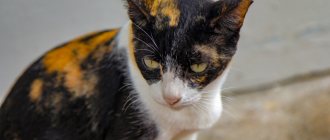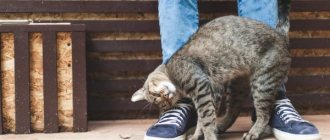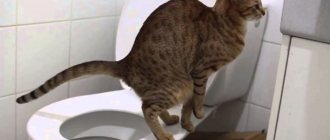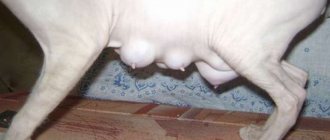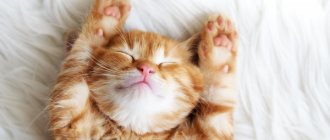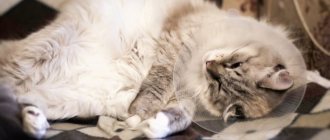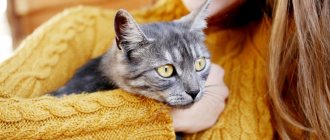Causes
Why does a cat have nosebleeds? The following reasons:
- Injuries.
- Entry of a foreign object.
- Development of a neoplasm.
- Hypertension.
- Diseases of the mouth cavity.
- Pulmonary hemorrhages.
- Systemic blood diseases.
- Side effects of medications.
- Poisoning.
- Viral infection.
- Heatstroke.
Injuries
They arise as a result of fights with cats, dog attacks, beatings, falls, and accidents. In such a situation, pay attention to the intensity of hemorrhage. The bleeding most often goes away on its own, and when blood flows out in a trickle, cold is applied and the victim is taken to the clinic.
Nose bleeds after a fight
Foreign object entry
Cats are curious creatures; the spine of a thorny plant, a speck of dust, or a grain can get into their nostrils. The foreign body irritates the nasal mucosa, the animal tries to remove it and is injured. If the felinologist’s attempts to help the pet are unsuccessful, the animal is taken to the clinic.
Development of neoplasm
Tumors form in older cats. The pathological process develops gradually, the muzzle becomes asymmetrical. The tip of the nose takes on an unnatural color. Conjunctivitis occurs, the eye spheres may be of unequal size.
Hypertonic disease
An increase in blood pressure indicates cardiac or renal pathologies. The cause of bleeding is the rupture of the capillary walls.
Oral diseases
When eating excessively soft food, plaque forms on a cat’s teeth, which over time turns into dentolitis. Infection occurs, and purulent melting of the tooth tissue occurs. The process extends to the nasal sinus. Blood is released from the destroyed tissues and flows from the cat's nose.
Dental diseases cause nosebleeds
Pulmonary hemorrhages
They arise as a result of injury, pneumonia, and the formation and melting of a neoplasm. Blood is released drop by drop, but it is difficult to stop.
Systemic blood diseases
Blood clotting processes are disrupted. Pathology occurs due to increased destruction or decreased formation of platelets. In addition to bleeding, blood escapes from the vessels. Reddish spots form, visible on hairless surfaces - gums, inside the ear.
Side effects of medications
Nonsteroidal antiphlogistants thin the blood. It seeps through the vascular walls. The nasal mucosa is rich in capillaries. Bleeding occurs.
Poisoning
When carrying out deratization, rodents use poisoned bait containing an anticoagulant. In mice, blood clotting is impaired. Weakened rodents become easy prey for cats. The trouble is that the pet’s sensitivity to the toxic substance is higher than that of mice. Therefore, for a cat that has eaten a rodent, the concentration of the toxin is sufficient to cause poisoning. In addition to bleeding from the nose, profuse drooling is observed.
If the mouse is poisoned, the cat will start bleeding
Viral infection
Viral leukemia causes blood clotting problems. Neoplasms are prone to metastasis. The destruction of a tumor in the nose leads to disruption of the integrity of the vessels from which blood flows.
Heatstroke
Cats do not tolerate high temperatures combined with exposure to the sun. As a result, the capillaries are damaged and blood drips out.
First aid for a cat with a nosebleed
The appearance of blood from a cat's mouth or nasal passages leads the owner of the animal into a stupor or panic. It is necessary to calm down and carefully examine the pet, thus assessing the severity of the situation.
Next, it is important to calm the pet as much as possible, which will normalize blood pressure and prevent increased bleeding. You should not give your cat human sedatives on your own without first consulting a specialist.
Severe bleeding from the cat’s nose must be stopped by applying a cold compress to the back of the animal’s nose, and then taken to the clinic.
In a clinical setting, the animal will undergo a comprehensive clinical examination to make an accurate diagnosis and prescribe adequate treatment. Diagnosis of nosebleeds includes several laboratory tests:
- blood biochemistry;
- cytological examination;
- general blood analysis;
- urine analysis (to assess the functioning of the kidney structures).
We suggest you read: Mating cats for the first time, what owners need to know about mating
A more thorough examination includes endoscopy (if gastric blockage is suspected), x-ray examination of the sinuses, rhinoscopy and computed tomography. Additional diagnostic methods include conducting serological tests if a fungal infection or disease caused by ticks is suspected.
If bleeding starts suddenly, follow the instructions below:
- Remain calm and reassure your pet. Increased blood pressure due to overstimulation will increase the intensity of bleeding.
- Place an ice pack on the bridge of your nose (over your muzzle). The ice pack should be wrapped in a soft towel to prevent damage to the vessels by the cold. Also, make sure your cat is breathing freely.
- Do not administer any medications unless prescribed by a veterinarian.
Remember that while bleeding continues, the cat will swallow some of the blood. The blood is partially digested and the stool may turn black. If the bleeding is too heavy, your cat may vomit bloody clots.
A specialist can diagnose internal bleeding in a cat using the following diagnostic methods:
- external examination and palpation;
- Ultrasound, x-ray of the abdominal organs;
- uterine smear cytology;
- histology of biopsy material;
- biochemical, general and blood clotting tests;
- Analysis of urine;
- vaginoscopy;
- bac sowing
Ultrasound of the cat's abdominal cavity
Based on the results of the study, the doctor prescribes the necessary treatment:
- antibiotics to prevent infections and inflammatory processes in combination with probiotics;
- surgery in case of detection of oncology, endometritis;
- chemotherapy to exclude relapse after surgery;
- blood transfusion in case of significant blood loss;
- antishock therapy;
- drugs to restore blood clotting.
Important! It is strongly recommended to adhere to the treatment prescribed by your veterinarian at home, this applies to the regimen, duration of administration and dosage of medications. After completing the course of treatment, you need to go to the clinic once a month for prevention.
Thus, bleeding in a pet is the most risky symptom of many terrible ailments. If you suspect such a condition, you should immediately seek help from a veterinarian.
So, the cat has blood coming out of its nose. If a runny nose initially occurs and streaks of blood appear in the mucus, this condition is most likely not critical, although it also requires certain actions (more about this in the article “What to do when a cat sneezes and has snot?”).
The release of drops, and even more so a trickle of blood, can seriously frighten the owner. What to do if your cat has a bleeding nose? First of all, put off panic. The owner's anxiety can agitate the pet, and this will lead to increased blood pressure and, as a result, increased bleeding.
Try to calm down: now the health of your beloved animal depends on your composure. Provide your pet with silence and a calm environment.
If moderate to severe nosebleeds develop, it is better to adhere to the following algorithm of actions:
- Apply something cold to the bridge of your nose, such as an ice pack or something wrapped in a cloth from the freezer. This must be done in such a way as not to prevent the animal from breathing freely.
- Find out where the nearest veterinary clinic equipped with a rhinoscope is located. If there is no one nearby, then go to any other one or call a veterinarian at home.
- While you are waiting for a doctor's examination, if possible, carefully examine the animal yourself - its face and mouth. Remember what medications you gave the cat, whether there was access to the street, etc. If the animal feels unwell, has pale mucous membranes and rapid breathing, and the bleeding continues, then the clinic can see you without a queue.
If veterinary care is not available, cold treatment should be applied until the bleeding subsides. You can gently rinse your nose with aminocaproic acid - this is a hemostatic agent sold in a regular pharmacy. We talked in detail about the technique of rinsing the nose of cats in the article “What to do at home if a cat sneezes?”
Unfortunately, it is impossible to determine the exact causes at home - only a specialist can do this.
We invite you to familiarize yourself with: Thai cats: features of the breed and maintenance
Diagnostics
Anamnesis is important. The veterinarian needs to find out the cause of hemorrhage. With unilateral bleeding, mechanical damage or a tumor process is suspected. If discharge is observed from both nostrils, probable preliminary diagnoses include the following:
- poisoning with anticoagulants - the cat ate a mouse during deratization;
- side effects of medications;
- infection.
The doctor prescribes the following studies from the following at his discretion:
- standard blood and urine tests;
- identification of pathogens through serological tests;
- superficial rhinoscopy;
- X-ray of the nose, chest;
- endoscopic examination of the nasal passages.
The cat gets an x-ray
What are the types of bleeding in cats and their symptoms?
Bleeding is divided into acute and chronic. Chronic bleeding is characterized by constant bloody drips from the nose. Acute bleeding begins abruptly and is practically asymptomatic.
In addition, bleeding is divided into bilateral and unilateral. It is important to understand that unilateral bleeding (the appearance of blood from one nostril) more often signals the presence of a foreign object in the nose, a tumor process, or mechanical injury.
If blood flows from both nostrils, the cause lies in infectious lesions of the respiratory tract or intoxication with zoocoumarins.
If the following symptoms appear during a nosebleed, it is recommended to immediately consult a veterinarian for help. The following signs are dangerous:
- the appearance of blood when sneezing;
- discharge of blood from the nasal sinuses, accompanied by signs of periodantosis or gumboil;
- the appearance of blood from the nose and mouth (there is a high probability of damage in the cat’s mouth);
- staining of feces black (feces become tar-like due to internal bleeding, while there may be no blood from the nasal passages);
- the appearance of an unpleasant odor from the mouth and breathing of the animal;
- violation of the act of breathing (shortness of breath, noisy inhalation and exhalation);
- loss of appetite.
Diagnosis and treatment
What you should tell your doctor:
~
Is your cat currently taking medications?
If yes, which ones? ~
Is there rat poison in the house? Could the cat have eaten a poisoned rodent?
~
Has she interacted with another animal?
Did she go for a walk without your supervision? ~
Has the cat had any injury, fall, blow, contact with sharp-edged objects or plants with hard spines?
~
Is the cat sneezing?
Rubbing his nose with his paws? ~
Has the cat vomited or had bloody stools?
If so, before or after the nosebleed? ~
Was the bleeding from one nostril or both?
~
Is there blood in the cat's mouth?
Are her teeth okay? Is the mucous membrane of the mouth pale or marbled in color? (you should open the cat's mouth and inspect the gums). ~
Are there any hemorrhages on the skin, swelling on the body (subcutaneous bleeding)?
~
Does your pet have breathing problems?
~
Does he have any noticeable asymmetry or deformation of his muzzle, or swelling of the bridge of his nose? Are eyeballs the same? Are your eyes watering?
The answers to these questions will help the veterinarian in clarifying the picture of the disease.
To make a diagnosis you may need:
General blood tests
(with platelet count)
and urine
- to assess blood loss and general health, kidney function, infection or inflammation;
biochemical blood test
- to assess the functioning of internal organs. The rate of coagulation is also determined.
Serological tests
— for detection of fungal diseases, rickettsial infections, etc.
Pressure measurement
– to exclude arterial hypertension.
Chest X-ray
- to exclude pulmonary hemorrhage as a result of edema or tumor.
X-ray of the nose
- to evaluate the roots of teeth and nasal sinuses, to identify possible bone destruction due to a tumor, etc.
Superficial rhinoscopy
– to examine the nasal cavity and remove foreign bodies if necessary.
Dental examination
– to exclude tooth root abscess or other inflammations affecting the nasal sinus.
Deep endoscopic examination of the nasal passages
- if it was not possible to establish a diagnosis using the above methods.
Tissue biopsy
– only if indicated (for example, detection of a tumor during an X-ray examination). The prognosis of cancer depends on the type of tumor.
Surgical method
- to remove a hard-to-reach foreign object or take a tissue sample. It is used only in exceptional cases, since the procedure is very traumatic and is accompanied by severe bleeding.
Some of the above diagnostic methods require the use of anesthesia(!).
Treatment is prescribed by the doctor depending on the diagnosed disease.
Unfortunately, the cat cannot say when, how or why it started bleeding.
Because nosebleeds can signal a serious problem, it is important to seek prompt medical attention.
Nosebleeds are a rather unpleasant symptom that can occur not only in humans, but also in cats. The cause of the problem in animals is various factors. The owner must know how to stop a cat from bleeding from the nose, and then find out what was the provoking factor for this disease and, if necessary, begin treatment for the disease or injury.
Colds - causes, symptoms, treatment
Just like in humans, colds in cats are a consequence of hypothermia. A thick fur coat does not always protect your pet from the cold.
When wet, wool loses its heat-saving functions, so make sure that the cat is warm after bathing. Another 100% way for a cat to catch a cold is a draft. Do not place food bowls or litter trays in drafts, or lay cat bedding in such places.
Cold symptoms:
- mucous discharge from the nostrils;
- watery eyes;
- sneezing, coughing, snorting;
- dry, hot nose;
- hot ears;
- weakness, apathy.
To cure a cold and, as a result, get rid of a runny nose, place the animal in a warm room and avoid drafts. Rinse your nose and eyes with a solution of potassium permanganate or weak green tea.
Eucalyptus inhalations help a lot. Bring the hot broth to the cat's face; you can cover the head with a napkin. Usually, a pet with a cold tolerates the procedure calmly, because he is exhausted and apathetic. Otherwise, wrap the cat in a towel and hold it in your arms.
Be careful that the animal does not get burned by the broth.
If your cat has a high fever, wrap the animal's body in gauze soaked in cold water. “Human” medicines like paracetamol should not be given to animals. If the fever does not go away, you need to contact your veterinarian. The doctor will administer a special antipyretic drug.
Signs of a serious illness
Experts identify quite a few diseases that provoke poor blood clotting. In case of illness, the animal may also experience other symptoms - for example, red spots on the ears and gums, pale gums. Also, the cat may not want to get out of bed in the morning and will lie all day due to loss of strength and lethargy.
Reduced blood clotting in cats can occur due to diseases such as viral leukemia and viral immunodeficiency. It can be caused by side effects of anti-inflammatory drugs. Another common reason is as a result of pathologies of the systems responsible for blood clotting, for example, disseminated intravascular coagulation syndrome, liver failure, hemophilia.
Note!
Severe purulent discharge with blood from the eyes or nose may also indicate the presence of worms.
Blood when sneezing
Bleeding when sneezing can be caused by inflammation or irritation of the nasal mucosa. As a result of prolonged and severe sneezing, heavy bleeding may occur, as well as a slowdown in natural blood clotting.
Blood when sneezing
If your pet does not stop sneezing blood for a long time (more than 1-2 days), you should urgently contact a veterinarian. At home, it is very difficult to determine the cause of the disease, much less help the animal. First aid can be effective depending on the situation, but if the cause of the bleeding is unclear, then doing it on your own can even harm the cat.
Note!
If cuts and scratches are noticed in the nose, they will need to be treated. For this, it is best to use an antiseptic without a strong odor, a spray for cats, or a special wound-healing ointment.
Flux or periodontal disease
If you have symptoms of periodontal disease or gumboil in case of bleeding in the nasal cavity, you should contact your veterinarian. The pet's nasal or oral cavity may become swollen, which will become a serious obstacle to the animal's normal functioning.
Unpleasant smell
Bloody nasal discharge in animals may be accompanied by an unpleasant odor. The reasons may be different, for example, an unpleasant odor may occur as a result of foreign bodies entering the nose. If a cat sneezes with blood, the nasal discharge is green and has an unpleasant odor, then most likely the pet has picked up some kind of virus. These same symptoms appear in leukemia, so they should not be ignored.
Important!
Diagnosis and treatment should be carried out exclusively by a specialist - inadequate assistance will only do harm.
Labored breathing
Difficulty breathing accompanied by bleeding may indicate swelling in the nasal cavity. These can be either malignant neoplasms or swelling as a result of inflammation or an allergic reaction. The cause may also be a foreign body that has entered the nasal cavity.
The kitten has lost its appetite and is having difficulty breathing
Loss of appetite
Loss of appetite, general weakness and lethargy are most often observed in infectious diseases. Sometimes an animal may refuse to eat due to pain in the mouth and nose while chewing. In this case, the pet should be checked for tumors in both cavities.
Allergies - how to recognize and treat?
Symptoms of an allergic reaction:
- clear discharge is observed from the nose;
- the animal sneezes;
- The cat rubs its eyes and nose with its paws - a reaction to irritation of the mucous membranes.
The most common cases of allergies are reactions to dust, tobacco smoke and flowering plants. Often there are allergies to household chemicals or cosmetics of the owners, sometimes to food or medicine.
If you suspect what your cat is allergic to, avoid your pet's contact with the potential allergen. If the condition improves, then the cause has been found.
If you are unable to identify the allergen on your own, consult a doctor - he will prescribe tests and, for treatment purposes, antihistamines.
Diagnosis and treatment
Only a veterinarian can determine the cause of bleeding in a cat, based on the results of a comprehensive examination of the animal.
When your nose bleeds
The “severity” of therapy depends directly on the underlying underlying cause. In case of an infectious disease (cold), the animal will have to undergo a course of treatment with antibiotics and antimicrobials. If the cause of bleeding is a severe oral disease or a tumor in the nasal cavity, then surgery will most likely be required.
If the diagnosis does not reveal any serious pathologies, then the approach to therapy is greatly simplified. In this case, you should apply cold to the pet's nose, and also use vasoconstrictor medications that can help stop the bleeding.
How to properly treat a cat
When he sneezes blood
Before contacting a doctor, the owner should carefully monitor the cat's behavior. If sneezing is not frequent, mucus is released from the nose along with blood, the animal’s breathing is difficult, and swelling around the eyes begins to appear, then the kitten is probably suffering from allergies. In this situation, the only way out is to stop the pet's contact with allergens.
In case of increased body temperature, apathy and weakness, cough accompanied by nasal discharge, the animal should be checked for the presence of an infectious disease. As already mentioned, antibiotics are prescribed to animals for infections.
Important!
If tumors are detected, a biopsy is performed and the feasibility of surgery is assessed.
If bleeding is caused by complex injuries and deep penetration of a foreign object into the body, then most often they resort to surgical methods.
Prevention is better than any cure. You should not bring the animal to a painful state; the problem should be stopped in the bud. Your pet should be taken to the veterinarian at least once a quarter for preventative purposes. A professional doctor will be able to promptly detect signs of a dangerous pathology that threatens the cat’s health.
Of course, almost everyone has seen and heard a cat sneeze blood. If this event is not observed very often, you can simply joke about it and forget about it. And if such cases are repeated with quite a lot of frequency, this should attract the close attention of the owners. It is necessary to take a closer look at how the animal behaves; perhaps there are some symptoms that bother it. There are several reasons why sneezing can be annoying even for a small kitten. We will try to figure out why a cat sneezes and produces blood.
Let's start with the fact that sneezing is a normal physiological process. But sometimes an animal can behave quite suspiciously, not as usual. Frequent sneezing is one of these noticeable symptoms. It must be understood that obvious violations indicate that the animal has health problems.
The most common cause of cat sneezing is viral diseases (in this they are similar to us): rhinitis, colds, adenoviral infections and exacerbation of herpes.
There are other infections that are not very easily tolerated by animals: peritonitis, leukemia virus, bordetellosis, chlamydia.
It often happens that the sounds made by a pet represent a typical allergic reaction. After all, every body can contain “personal” allergens, that is, substances that can cause allergies. Commonly encountered ones include: dust, pollen, mold, candle wax, cigarette smoke. It is necessary to remove as strong odors as possible, because they can make any animal’s eyes water.
These are the possible situations associated with sneezing. The reasons for this may also lie in pathologies of the fluffy’s nasopharynx. It happens that polyps or growths appear in the nasal sinuses of cats. It is because of this that animals may feel like they are short of air. You just need to listen to your pet and pay attention to its behavior. If there is shortness of breath, if the cat (or cat) sniffles with its nose, and also periodically breathes through its mouth, then in most cases the cause is polyps. The owners of furry animals can see them themselves; simply point a flashlight into the animal’s nasal passages to see the pinkish growths.
Cats can also sneeze due to an asthma attack. Usually he goes “in company” with coughing and sneezing. Often the development of asthma occurs due to allergic reactions that become chronic. The most basic assistance that can be provided in this case is to hold the animal’s face over water vapor for about two minutes. The hot steam will dilate the bronchi and other airways and make it easier for the cat.

